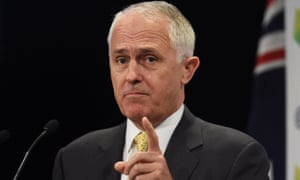Extract from The Guardian
The PM has no room for financial generosity before
the election, so must rely on clever politics and his initial burst
of popularity to carry him through
Malcolm Turnbull faces an unusual mix of political
popularity and economic downturn. Photograph: Mick Tsikas/AAP
Lenore
Taylor Political editor
Tuesday 15 December 2015 13.55 AEDT
This budget
statement shows how fundamentally Malcolm Turnbull is going to
have to try to turn politics on its head.
Governments usually spend political capital in the
first half of the term and money in the second. But the timing and
circumstances of Turnbull’s ascent to the prime ministership mean
he is in the highly awkward position of having to do the reverse.
He has no money to spend, in fact the budget
deficit has blown
out by $26bn over the forward estimates in the seven months since
May – it’s up to $37.4bn this year – and net debt stays higher
for longer.
Even accepting that the “debt ’n’ deficit
disaster” hyped by Turnbull’s predecessor was always a hyperbolic
overstatement, these numbers show clearly that two years into
Coalition
rule, the economy is not yet headed in the direction they promised
and the end of the commodity boom remains a problem for which they
have not yet found a solution.
And since Turnbull justified the leadership coup
with the argument that the country needed new economic leadership and
an end to intelligence-insulting slogans and spin, he is going to
have to come up with some potentially unpopular decisions in next
year’s budget to provide a convincing explanation about how he
intends to turn things around.
The savings in the midyear statement are carefully
calibrated to avoid too many negative headlines – another $1.3bn
from welfare fraud because of data matching between Centrelink and
the tax office, on top of the $1.6bn in welfare compliance savings
already booked last May, $534m from payments to aged care providers
and $650m from ending incentives for bulk-billing pathology,
diagnostic imaging and MRIs.
But those savings were needed to offset what the
government has spent since May – almost $1bn to pay for the special
intake of refugees from Syria, $1.1bn for the innovation statement
and some extra money for roads and asylum seekers waiting in
Australia for processing.
And the government has acknowledged the cost of
the “delays” in many budget 2014 measures blocked by the Senate,
but has still not acknowledged political reality and taken them out
of the budget.
To make good on the promise of turning the economy
around, Turnbull needs to do much more than that by May, crashing
straight into the political cycle of an election year.
Even taking into account treasurer Scott
Morrison’s slightly tortured holiday road trip metaphor to explain
the patient road back to surplus (the careful route of restraining
expenditure and trying to boost growth, rather than the potentially
destructive shortcut of slashing spending – and voters should not
get impatient and start asking “are we there yet?” from the back
seat) the government knows it has to explain how it will speed things
up in the budget next May and its pre-election manifesto.
But Tony Abbott already did a pre-election budget
last May – a desperate attempt to climb out from underneath the
political disaster of his first budget and get ready for a possible
national-security focused election early next year.
The good news for Turnbull is that the change of
prime ministership has given the Coalition the political capital to
spend. The latest
Newspoll shows the Coalition ahead 53% to 47% on
two-party-preferred terms and Turnbull the preferred prime minister
of 60% of the nation.
His big judgment now is how to balance those
political numbers against the worsening economic ones in the budget.

No comments:
Post a Comment